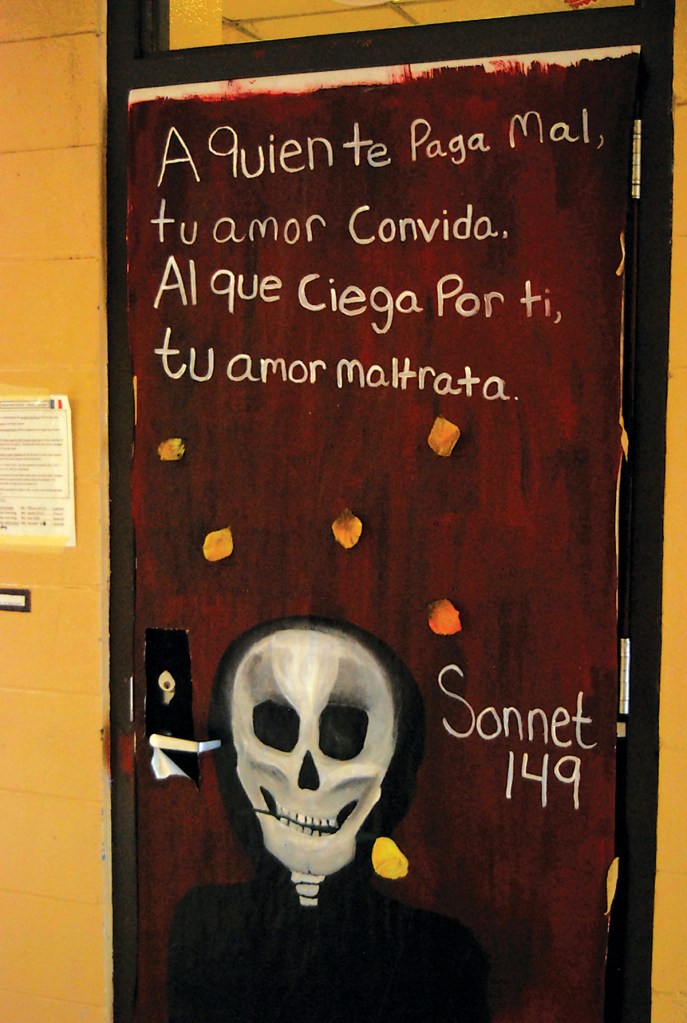Indelible Words
Published 7:13 pm Monday, April 11, 2016

- The French and Spanish classrooms share the hall with the English Department at NISH. The language arts instructors requested the Shakespeare artwork on their doors be reflective of the language students were learning in the classrooms. Artist statements are planned to explain the interpretations.
Visual poetry exhibit aims to delight and instruct
How many times do great “words of art” come into play on an average day? More than most might think, according to Kim Holleman, media director for Promotional Images Advertising in New Iberia.
“We’re exposed to it every day” Holleman said. “From our end, sometimes people want to put a lot of words on a small space but if you have a powerful graphic or photo that portrays what you want to say, you shouldn’t have to use a lot of words.”
Quotes from famous and even unknown people through advertising and entertainment often become catch phrases in everyday life.
“Sounds Greek to me,” “he’s eaten me out of house and home,” or “the first thing we do, let’s kill all the lawyers,” are words written by William Shakespeare, a renowned wordsmith who died 400 years ago this spring. “I’ll not budge an inch,” “What’s done is done,” and “I have not slept one wink,” are three more phrases attributable to Shakespeare.
Meeting the Legend
So how does a group of high school English teachers convey the importance of words to their students during National Poetry Month?
“The students start out thinking (with panic) ‘You want us to interpret poetry?’ But as the project moves along they get very excited about what they’re doing,” said Rebecca Gipson-Turluck, head of New Iberia Senior High School’s English department. “It’s amazing what these kids can do.”
Ancient philosophers Aristotle, Horace and the romantic poet William Wordsworth all embraced the idea of “delighting and instructing.” That same philosophy is now on display in the language hallway.
For several years the NISH English department worked to show students how to enjoy rather than fear poetry through a series of activities like sidewalk décor, themed dress up days and a trivia competition. Students participated in poetic trading card exchanges and carried poems as part of Poem in Your Pocket Day.
“Three years ago, the department was looking for a way to revitalize our Poetry On the Go display,” said Gipson-Turluck. “I asked Jena Broussard Richardson if her fine arts students could transform poems into art to be displayed on the classroom doors. She agreed and Poetry On the Go transformed from a fun project to a fabulous art exhibit.”
This year’s collaboration theme coincides with “The Wonder of Will,” the Folger Shakespeare Library’s commemoration of Shakespeare’s death. The English teachers were asked to pick a favorite scene from a Shakespeare play or a Shakespearian sonnet for art students to illustrate. Gipson-Turluck said the exhibit is a visual embodiment of Shakespeare’s ideas.
“Visual Poetry: A Doorway to the Works of William Shakespeare,” was chosen as the theme by Richardson and her students for the 2016 NISH exhibit.
“Shakespeare is for everybody, no matter what time period, skin color or ethnicity,” Gipson-Turluck said. “You can still understand the emotions behind it. They never get old and never go away.”
Motivation for Creativity
Richardson devised a lesson plan that required students to work in groups, perform preliminary research, and work on sketches before any actual painting began. Eventually the painting portion became “beautiful artistic chaos” down the art hall. Ideas were debated, supplies passed around and the students came together as a supportive network.
“The poetry project pushed the students to their creative limits,” Richardson said. “In the beginning they are excited, but also intimidated by the concept.”
From an educational standpoint, one of the most important things about the Visual Poetry exhibit is that it is cross-curricular, Gipson-Turluck said. Curriculum standards mandate students interact regularly with various sorts of texts, make connections between texts and learn to interpret information presented in various print documents as well as in non-print forms.
The non-print form is the idea that a painting can be projected on the board for students to interpret in writing what the painting is about. Gipson-Turluck said they’re teaching students to reach out to evidence in text that encourages critical thinking. They’re asking them to make their argument and tell how the opinion applies.
“This project coincided with those guidelines and allows the general student population to experience and learn about the sometimes scary Shakespeare in an approachable and appealing format,” Gipson-Turluck said. “The work Mrs. Richardson and her students produced is so beautiful that it literally stops traffic. Given the high volume of traffic in the halls at NISH, that is a real testament to just how powerful both visual arts and poetry can be.”
The Visual Poetry display was premiered March 14 during NISH’s Open House. The exhibition will continue to hang through the month of April. During this time, the English Department is also selling “I Read Dead People” and “Poets Have Power” T-shirts to celebrate National Poetry Month. In this way, Gipson-Turluck said, even casual fashions can delight and instruct.
Practical Poetry
One year during the art and poetry project, a Whitman poem was the basis of an Apple commercial. The students watched the YouTube video over and over to hear the lyrical commercial that manifested how poetry is often used in everyday life.
Bugs Bunny and other characters in modern art are often quoting Shakespeare but without the study of his works, the familiar might go unnoticed as historically significant.
Holleman said there is a place for young people in media and marketing but when they come from college, no matter what career is chosen, it takes work ethic and realizing you don’t start at the top.
“Regardless of the rare ‘Google’ or ‘Facebook’ pros hitting it big quickly, the average worker coming out of college can’t expect the $60,000 paycheck, company car and all expenses paid job — that mentality is not reality,” Holleman said. “You have to start in the mail room and work your way up. Although technology bombards us everyday encouraging instant gratification, there’s no such thing in the work force.”
“Marketing, (marrying art and words), is so broad. You don’t want to lose the personal touch that people deserve whether sending out an e-mail or marketing of any kind,” said Holleman. “Where there is such a barrage of stuff thrown in your face everyday, you have to have wordsmithing to make it pop even more but not to lose what makes you different, especially in marketing. What makes a company different from every other company? Personal touch.”
As a piece of creative advice, Holleman suggested students pick something of interest — journalism, marketing, social media and then specialize. Even as a junior or senior in high school, take classes out-of-the-box, explore something new. The experience might be enjoyable and provide for a means of finding a successful career, Holleman said.
Beyond a Lifetime
Newcomb Art Gallery at Tulane University has been selected by the Folger Shakespeare Library in Washington D.C. to host “First Folio! The Book that Gave Us Shakespeare,” a national traveling exhibition featuring the first collected edition of Shakespeare’s plays. The exhibition marks the 400th anniversary of William Shakespeare’s death.
The “First Folio” was compiled and published in 1623 — seven years after Shakespeare’s death — by two of Shakespeare’s fellow actors to preserve the writings for future generations. It features 36 plays, including Macbeth, Julius Caesar, Twelfth Night and Hamlet.
A month-long exhibit of Shakespeare’s “First Folio” will feature a jazz funeral and second line on May 9. The university also will cross the ocean to bring some Big Easy jazz flavor to Shakespeare’s hometown bash April 23.
“ ‘Not of an age, but of all time,’ was coined by Ben Johnson as an introduction to the first collection of Shakespeare’s writings. He believed they would never go away,” Gipson-Turluck said. “They never have.”





